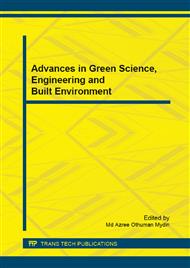[1]
Leslie, R.P., Capturing the daylight dividend in buildings: why and how? Building and environment, 2003. 38(2): pp.381-385.
DOI: 10.1016/s0360-1323(02)00118-x
Google Scholar
[2]
Edwards, L. and P.A. Torcellini, A literature review of the effects of natural light on building occupants 2002: National Renewable Energy Laboratory Golden, CO.
DOI: 10.2172/15000841
Google Scholar
[3]
Bodart, M. and A. De Herde, Global energy savings in offices buildings by the use of daylighting. Energy and buildings, 2002. 34(5): pp.421-429.
DOI: 10.1016/s0378-7788(01)00117-7
Google Scholar
[4]
Li, D.H. and J.C. Lam, Evaluation of lighting performance in office buildings with daylighting controls. Energy and buildings, 2001. 33(8): pp.793-803.
DOI: 10.1016/s0378-7788(01)00067-6
Google Scholar
[5]
Byrd, H., Post-occupancy evaluation of green buildings: the measured impact of over-glazing. Architectural Science Review, 2012. 55(3): pp.206-212.
DOI: 10.1080/00038628.2012.688017
Google Scholar
[6]
Zomorshidi, H., Iranian architecture- Building construction with the traditional materials2006, Tehran: Zomorrod.
Google Scholar
[7]
Li, D.H. and E.K. Tsang, An analysis of daylighting performance for office buildings in Hong Kong. Building and environment, 2008. 43(9): pp.1446-1458.
DOI: 10.1016/j.buildenv.2007.07.002
Google Scholar
[8]
Pirnia, M.K., An introduction to Islamic architecture of Iran2012, Tehran: Soroush Danesh.
Google Scholar
[9]
Memarian, G., Ashnaei ba Memarie Maskoonie Iran (Gooneh Shenasi Daroon gara) 2012, Tehran: Soroush Danesh.
Google Scholar
[10]
Shi, L. and M.Y.L. Chew, A review on sustainable design of renewable energy systems. Renewable and Sustainable Energy Reviews, 2012. 16(1): pp.192-207.
DOI: 10.1016/j.rser.2011.07.147
Google Scholar
[11]
Li, D., et al., A study of the daylighting performance and energy use in heavily obstructed residential buildings via computer simulation techniques. Energy and buildings, 2006. 38(11): pp.1343-1348.
DOI: 10.1016/j.enbuild.2006.04.001
Google Scholar
[12]
Pirnia, M.K., Iranian architecture styles 2001, Tehran: Islamic art publisher.
Google Scholar
[13]
Zomorshidi, H., Architecture of Iran, Vernacular material science2008, Tehran: Zomorrod Publisher.
Google Scholar
[14]
Babaei, M., H. Soltanzadeh, and S. Yahya Islami, A study of the lighting behaviour of Moshabak in Kashan's houses with emphasis on the notion of transparency. Architectural Science Review, 2012(ahead-of-print): pp.1-16.
DOI: 10.1080/00038628.2012.729309
Google Scholar
[15]
Belakehal, A., K. Tabet Aoul, and A. Bennadji, Sunlighting and daylighting strategies in the traditional urban spaces and buildings of the hot arid regions. Renewable energy, 2004. 29(5): pp.687-702.
DOI: 10.1016/j.renene.2003.09.001
Google Scholar
[16]
Arjmandi, H., M. Tahir, and M. Shabani, Application Of Transparency To Increase Day Lighting Level Of Interior Spaces In The Dwelling Apartments In Tehran–A Lesson From Iranian Traditional Architecture. Editorial Board/Sidang Editor, (2010).
Google Scholar


